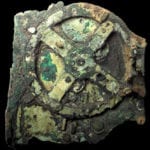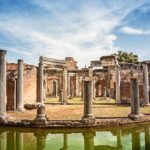 Creepy
Creepy  Creepy
Creepy  Technology
Technology 10 Scientific Breakthroughs of 2025 That’ll Change Everything
 Our World
Our World 10 Ways Icelandic Culture Makes Other Countries Look Boring
 Misconceptions
Misconceptions 10 Common Misconceptions About the Victorian Era
 Mysteries
Mysteries 10 Strange Unexplained Mysteries of 2025
 Miscellaneous
Miscellaneous 10 of History’s Most Bell-Ringing Finishing Moves
 History
History 10 Great Escapes That Ended Right Back in Captivity
 Weird Stuff
Weird Stuff 10 Fascinating Things You Might Not Know About Spiders
 Food
Food 10 Everyday Foods You Didn’t Know Were Invented by the U.S. Military
 History
History 10 Odd Things Colonial Americans Kept at Home
 Creepy
Creepy 10 More Representations of Death from Myth, Legend, and Folktale
 Technology
Technology 10 Scientific Breakthroughs of 2025 That’ll Change Everything
 Our World
Our World 10 Ways Icelandic Culture Makes Other Countries Look Boring
Who's Behind Listverse?

Jamie Frater
Head Editor
Jamie founded Listverse due to an insatiable desire to share fascinating, obscure, and bizarre facts. He has been a guest speaker on numerous national radio and television stations and is a five time published author.
More About Us Misconceptions
Misconceptions 10 Common Misconceptions About the Victorian Era
 Mysteries
Mysteries 10 Strange Unexplained Mysteries of 2025
 Miscellaneous
Miscellaneous 10 of History’s Most Bell-Ringing Finishing Moves
 History
History 10 Great Escapes That Ended Right Back in Captivity
 Weird Stuff
Weird Stuff 10 Fascinating Things You Might Not Know About Spiders
 Food
Food 10 Everyday Foods You Didn’t Know Were Invented by the U.S. Military
 History
History 10 Odd Things Colonial Americans Kept at Home
10 Fortresses That Were a Nightmare to Conquer
The art of defense in war is epitomized by the fort, whether simple wooden stockades or elaborately engineered complexes of walls, ditches, and towers. Throughout history, the defender has struggled to be one step ahead of the attacker’s tactics and weaponry. The results can be seen in many ingeniously designed fortresses that made invaders pay dearly for their capture.
The list below gives ten examples of such fortresses, ranging from the merely strong to the invincible.
Related: 10 Really Surprising Facts About Ancient Warfare
10 Masada
The Defenses: What made Masada almost impregnable was the sheer height of the isolated plateau on which it stands. The rock rises 1,424 feet (434 meters) from the arid desert floor southwest of the Dead Sea. It was further fortified by the Hasmoneans in the 2nd century BC before Herod the Great took it over as a site for his palace.
Herod surrounded the perimeter of the mesa with a 4,500-foot-long (1,372-meter) defensive double wall close to 20 feet (6 meters) high. The wall was punctuated by more than 30 towers and four gates. The aqueducts he constructed brought 200,000 gallons (757,082 liters) of water to the cisterns and, with the numerous storerooms stocked with food, assured that 10,000 defenders could survive for months.
Was It Conquered?: After the fall of Jerusalem during the great Jewish revolt, rebel remnants continued to defy the Romans from atop Masada. The Roman Xth Legion was dispatched to take the stronghold in AD 72. Nearly 15,000 Romans besieged a thousand Jews, including women and children, by building a ramp of stone and earth where they could wheel the siege engines to the summit. Once there, they were able to breach the wall. Rather than give the Romans the satisfaction of enslaving them, the garrison committed mass suicide.[1]
9 The Theodosian Walls
The Defenses: After the empire’s capital was moved to Constantinople, Roman emperor Theodosius II set about building its defensive walls, which were continually improved upon through the centuries. The enemy’s first obstacle was a ditch 65 feet (20 meters) wide and 23 feet (7 meters) deep that could be flooded with water. After this was an outer wall, then a second wall with towers and firing platforms.
Further beyond was a third wall 16 feet (5 meters) thick and 39 feet (12 meters) high, with 96 projecting towers, each capable of holding three artillery pieces. This entire complex was built on a rising embankment, and the plan made it impossible for siege engines to approach the inner wall. From these formidable defenses, the defenders could rain down their secret weapon—Greek fire—on the attackers.
Was It Conquered?: For 800 years, Persians, Slavs, Avars, Rus, and Bulgars all pounded their heads against the walls to no effect. In 1204, the Fourth Crusade captured Constantinople, but only because a gate had been carelessly left open. The city was restored to the Byzantines, but the empire was already in decline. When Ottoman Sultan Mehmed II came to take Constantinople in 1453, it was defended by only 7,000 men against a force of 50,000 to 80,000.
Mehmed brought with him the largest cannons the world had yet seen. The mightiest, the Royal Gun, needed 60 oxen to pull and 400 men to maneuver. Its stone shot weighed 1,500 pounds (680 kilograms). But even with such massive firepower, Mehmed found the defense so frustrating that at one point, he was ready to give up and offered to lift the siege if the Byzantines agreed to pay tribute. They refused, so Mehmed continued his ceaseless pounding until the walls finally gave. The Ottomans had retaken Constantinople after 53 days of merciless battering.[2]
8 Kenilworth Castle
The Defenses: Began in the late 11th or early 12th century, Kenilworth in Warwickshire is known primarily for its water defenses and walls-within-walls enclosure. From an original motte and bailey timber structure (a motte is an elevated area of ground dominated by a keep; a bailey is a walled courtyard), Kenilworth evolved into a stone castle further strengthened by King John from 1210 to 1216.
The Great Keep was provided with “fishtail” slits, an innovative design that allowed the firing of crossbows. The brooks nearby were dammed, creating an artificial lake: the Great Mere. Protecting all sides of the garrison except the north, the lake, the largest artificial water barrier in England, made the castle nearly impossible to take.
Was It Conquered?: In the uprising of the barons against King Henry III, Kenilworth, then in the hands of rebel Simon de Montfort, was besieged by royal forces from June to December 1266—the longest in English history. Prince Edward tried to crack open the defenses with heavy trebuchets and nine or eleven siege engines to no avail. Even a nighttime waterborne attack was stymied by the Great Mere. In the end, not military force but disease compelled the castle’s surrender.[3]
7 Mont St. Michel
The Defenses: Mont St. Michel’s location is forbidding enough. Built on a rocky tidal island off the Normandy coast, it can only be reached on foot at low tide. And the tides are strong and dangerous, with a 50-foot (15-meter) difference between highs and lows being normal. Sometimes, tides change so quickly that they turn the bay into quicksand. As if nature wasn’t enough of an obstacle, French kings Philip II and Louis IX further strengthened the island with defensive and exterior walls.
Was It Conquered?: Mont St. Michel’s defenses were continually upgraded during the Hundred Years’ War. The chancel of the church collapsed during the terrible siege of 1421, but otherwise, the citadel, defended by only a few knights, survived English attacks for 30 years.[4]
6 Krak des Chevaliers
The Defenses: Situated near the Syria-Lebanon border in what was once the Crusader county of Tripoli, the Krak incorporated the latest engineering techniques in 13th-century castle construction to keep up with the greater firepower of besieging armies in the form of counterweight trebuchets. These included more massive towers and thicker double walls with sloped outer bases to make them harder to breach.
Machicolations, loopholes, arrow slits, and “murder holes” were protected openings that allowed defenders to rain missiles on the enemy without exposing themselves. The Crusaders smoothed out the rock summit on which the Krak stood, denying attackers any handhold or foothold. The main gateway could only be reached via a hairpin bend, considerably slowing down the enemy. Ingenious changes in lighting levels wrought havoc on visibility.
Was It Conquered?: In 1271, the Muslim Mamluk leader Al-Zahir Baybars besieged the Krak. His catapults destroyed one of the outer towers, and two weeks were needed to breach the inner wall. The surviving few Knight Hospitallers held on for an additional 10 days in the largest tower of the inner wall until a forged letter allegedly from the Hospitaller Master instructed them to surrender.[5]
5 Kumbhalgarh
The Defenses: Located in Rajasthan state in northern India, Kumbhalgarh is surrounded by mountains 3,560 feet (1,087 meters) above sea level. The defensive walls total 20 miles (32 kilometers), with widths varying from 15 to 25 feet (4.5 to 7.6 meters). This was enough, it was said, to allow eight horses to run side by side.
Access is through a series of sharply turning ramps that are difficult to negotiate. Seven imposing gates with colossal iron doors studded with spikes awaited attacking elephants. Even if the enemy made it through, they had to navigate narrow passages and five-foot-high (1.5-meter) doors, not to mention the numerous confusing traps inside the fort.
Was It Conquered?: Since being built in the 15th century, the present fort had been invincible through numerous attacks. Finally, in 1576, Emperor Akbar’s treacherous general, Shahbaz Khan, resorted to poisoning the water supply. Finally, the defenders of mighty Kumbhalghar had to surrender or die of thirst.[6]
4 Hochosterwitz
The Defenses: Nestled on top of a 564-foot (172-meter) dolomite rock in the Austrian province of Carinthia, Hochosterwitz Castle can only be reached via a winding path blocked by 14 fortified gates. Any attacker had to capture each gate in succession, all the while being ambushed by defenders from the sides. Aside from this main defensive feature, the castle has the customary square tower and walls.
Was It Conquered?: The gates were constructed between 1571 and 1600 in the age of Turkish incursions into Austria. The Ottomans attempted to take the castle but were never able to get past the fourth gate. Hochosterwitz proved invincible and remains in the possession of the same family to this day.[7]
3 Castillo de San Marcos
The Defenses: Built by the Spanish between 1672 and 1695 at St. Augustine, Florida, San Marcos is the oldest existing seacoast fort in the continental U.S. With the advent of gunpowder, fortress design had undergone a revolution to remedy the vulnerability of traditional square strongholds to cannon fire. The star-shaped bastion, like the one at San Marcos, minimized the surface area a cannon shot could hit perpendicularly and with force. Moreover, defenders had a greater arc of fire on the enemy, and those who reached the walls could be raked by fire from the sides and rear.
But San Marcos had an added bonus: the walls were made of coquina, a local limestone found along the coast. Created from the shells of coquina clams, the stone contains millions of microscopic air pockets, making it compressible. The Spanish were not aware of this at the time, so they made the walls 35 feet (10.7 meters) and 12 to 19 feet (3.7 to 5.8 meters) thick to offset what they thought was the liability of using soft stone. A surprise was in store for them and the enemy.
Was It Conquered?: British forces from South Carolina laid siege to St. Augustine in 1702, burning the town and bombarding the fort. But instead of pulverizing its walls, British shells were either deflected or harmlessly buried themselves into the soft rock. The porous nature of the coquina simply absorbed the cannonballs. After 50 days of such futility, the British gave up.
They tried again in 1740 with the same result. San Marcos was never taken by force. It was ceded by treaty to the British after the Seven Years’ War.[8]
2 Murud Janjira
The Defenses: An oblong fort on an island in the Arabian Sea, there was no way to approach Janjira but by the sea. Any enemy would then have to contend with 40-foot (12-meter) high walls with 19 bastions defended by more than 500 strategically placed cannons. These include three of the largest cannons in India, with the heaviest, Kalal Bangadi, weighing 22 tons and could reportedly fire a projectile up to 7 miles (12 kilometers).
Was It Conquered?: The Maratha ruler Chatrapathi Shivaji attempted to take the fort thirteen times between 1659 and 1678 but failed. His son Sambhaji tried building a causeway from the shore to the fort. He was on the verge of capturing it until he was distracted by an attack on one of his own forts and was forced to retreat. Even the superior firepower of the Portuguese, Dutch, and British was no match for Janjira. The fort was never conquered.[9]
1 Switzerland
The Defenses: Put simply, the entire country is a fortress, protected on all sides by towering Alpine mountains. Called the Swiss National Redoubt, it is a complex of bunkers, tunnels, shelters, warehouses, and other military installations hidden within the mountains. During the Cold War, roads, bridges, and railroads were rigged with explosives to ensure their complete destruction and make them useless to any invader.
Mountainsides along roads were also booby-trapped to trigger artificial rockslides. The entire populace could hide in thousands of bomb shelters for long periods. In addition, all able-bodied males to this day have military training. In World War II, they were instructed, in the event of a German invasion, never to surrender and, if necessary, flee to the mountains and fight individually.
Was It Conquered?: The Nazis’ contempt for “the stinking little state” prompted Operation Tannenbaum, the plan to invade Switzerland. But realizing the costs of subjugating the country deterred them from realizing the plan. No one has since dared to mess with the Swiss.[10]








